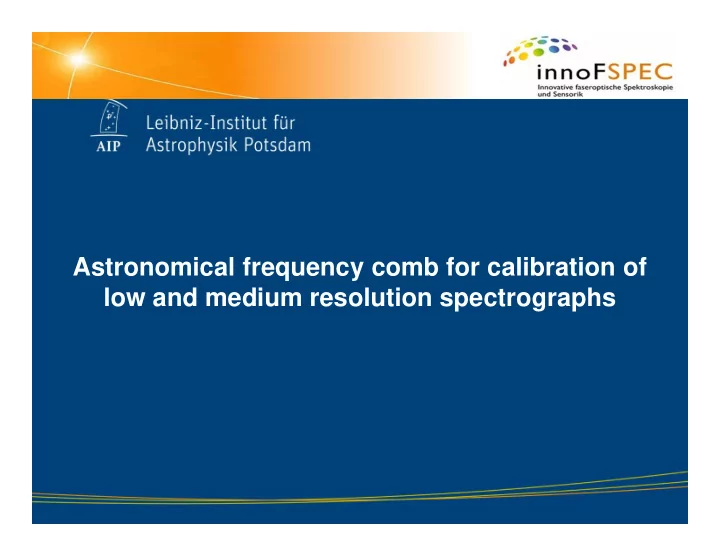

Astronomical frequency comb for calibration of low and medium resolution spectrographs
innoFSPEC at AIP has several years expertise in astronomical instrumentation. innoFSPEC succesfully developed a new technique to generate an optical source (called astro-comb) suitable for calibration of low and medium resolution spectrographs. The instrument is compact and easy to operate and has been tested on-sky using the Potsdam Multi-aperture Spectrometer (PMAS) at the 3.5 m telescope at the Calar Alto Observatory (Spain). The instrument offers a continuous tune of the position of the calibration lines – this brings the possibility of a complete characterization of the line spread function of the spectrograph at any resolution. We seek for partners at GEMINI that can use this instrument and could request for additional features of our tunable calibration source.
The next slides describe the standing problems in wavelength calibration and results of the on- sky test with the frequency comb source developed at innoFSPEC Potsdam
Wavelength calibration Calibration light Use of astronomical instrumentation relies heavily on accurate calibration procedures. science CCD pixel Spectrographs are calibrated in: wavelength and flat field. Throughput: Response of whole telescope optics and spectrograph. Accurate wavelength calibration is required for: • Search for extra-solar planets via the radial velocity method. • Search for time variation of the fine structure constant ( α ). • Measurement of the acceleration of the universe expansion. • Stellar population. Wavelength calibration sources: • Lamps of He, U-Ne, Th/Ar, Hg. • Iodine cells. 4
Calibration sources Lamps characteristics limit the accuracy of wavelength calibration: Lines are not equally spaced nor equally intense. Lines are blended. Narrow spectral coverage. / λ = 10 -7 accuracy. Lines’ frequencies are known with ∆ λ He lines Flux Wavelength Wavelength (Å) ‘Ideal’ wavelength calibration source: Equally spaced and equally intense lines. Lines spaced 3-4 times the resolution of the spectrograph. Spectral coverage over the whole spectrograph operation range. / λ = 10 -8 accuracy or better. Lines’ frequencies known with ∆ λ 5
Astro-comb Astronomical combs (astro-combs) have the characteristics of an ideal calibrator: but too tightly spaced lines. Comb mode spacing is increased by filtering with Fabry-Perot cavities. Stabilization 0.5 GHz (2pm) Fabry Perot cavities electronics crosstalk >20 GHz (80pm) To spectral Octave- broadening spanning laser-comb Before filtering after filtering Stabilization electronics Astro-combs are commercially available at 500-700 K Euro 6
Any alternative to actual astro-combs? Actual astro-combs are complex and expensive. We developed a tunable and compact astro-comb for medium and low resolution spectrographs. The astro-comb stability is tracked with a wavemeter having 0.3 pm resolution. The comb lines are stable within 0.025 pm during the astro-comb exposure time. 1555,172 Wavelength (nm) 1555,170 1555,168 b) a) 1555,166 1555,164 0 2000 4000 6000 8000 10000 Time (s) 7
Comb generation bandwidth Initial lasers Broadband spectrum (400 nm 23 THz bandwidth) centered at 1580 nm. Optical-signal-to-noise ratio > 30 dB. 170 equally spaced lines are generated out of 2 lasers. After frequency doubling, spectrum is centered at 800 nm. 8
On-sky test with PMAS at Calar Alto PMAS : Integral Field Instrument at the Calar Neon Alto Observatory 3.5 m telescope: - Wavelength coverage from 390 to 930 nm - 4096 × 4096 CCD detector with 15 mm pixel size. - Resolution of ~7000 (@800 nm). Neon Neon: 20 randomly distributed lines with very unequal intensities. Astro-comb Astro-comb: 300 lines evenly spaced in frequency. 0 2 Astro-comb 5 5 9
Gaussian fitting A P3d data reduction software allows analyzing the measured spectra. Each comb line is sampled by ~5 pixels: fitting uses a Gaussian function. Determination of the centroid and the width of each comb line. Calculation is performed for each width of the 400 fibers. centroid Line profile (width) measures the resolution of the spectrograph. 10
Tunability of astro-comb 420 The astro-comb can be set Frequency (THz) 400 for several comb spacing. 380 a) Approriate for low-, medium- and 360 294.14 ± 0.005 GHz high-resolution spectrographs. 340 0 50 100 150 200 250 300 Comb line Frequency equidistancy is verified with 1 pm accuracy. 410 454.34 ± 0.03 GHz 400 Frequency (THz) Useful for assessing line spread function 390 380 characteristics . 370 360 350 340 0 20 40 60 80 100 120 140 Comb line 11
Sky lines exposures with PMAS 6000 Intensity (linear units) Exposures of OH emission lines were a) b) Intensity (linear units) 7500 calibrated either with Neon (black) or 4800 6000 astro-comb (green and red) light. 3600 4500 3000 The wavelengths of the OH doublets 2400 1500 are indicated with vertical lines. 780 800 820 840 774,8 774,9 775,0 775,1 775,2 775,3 Wavelength (nm) Wavelength (nm) Due to the lack of Neon lines at some c) d) 7500 Intensity (linear units) 7500 Intensity (linear units) spectral intervals the calibration is 6000 6000 Inaccurate up to 20 pm. 4500 4500 Astro-comb offers more accurate 3000 3000 wavelength calibration. 1500 1500 834,2 834,3 834,4 834,5 834,6 834,7 842,8 842,9 843,0 843,1 843,2 843,3 Wavelength (nm) Wavelength (nm) 12
Ca-triplet exposures in stars 18000 a) 16000 Intensity (linear units) Exposures on several stars to analyze 14000 Ca triplet absorption lines. 12000 10000 Wavelength calibration is performed 8000 with Neon and astro-comb. 6000 Examples with HD3765 and HD219538 848 852 856 860 864 868 Wavelength (nm) show the ability of astro-combs to perform wavelength calibration perhaps 16000 b) with superior accuracy than Neon lamps. Intensity (linear units) 14000 12000 10000 8000 HD3765 HD219538 6000 853,0 853,5 854,0 854,5 855,0 855,5 Wavelength (nm) 13
Conclusions Simple scheme for tunable astro-comb generation was demonstrated. Astro-comb provides much more calibration (stable) lines than lamps. On-sky test shows astro-comb suitability through examples with OH emission lines detection and stellar exposures. 14
Contact information: Dr. Jose Boggio (jboggio@aip.de) Dr. Domenico Giannone (dgiannone@aip.de) InnoFSPEC-VKS, Leibniz-Institut für Astrophysik, Potsdam, Germany
Recommend
More recommend